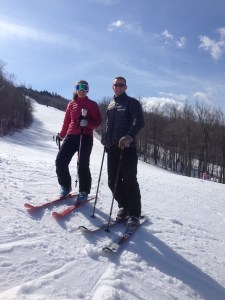NOAA Teacher at Sea
Emily Whalen
Aboard NOAA Ship Henry B. Bigelow
April 27 – May 10, 2015
Mission: Spring Bottom Trawl Survey, Leg IV
Geographical Area of Cruise: Gulf of Maine
Date: May 5, 2015
Weather Data:
Air Temperature: 8.4°C
Water Temperature: 5.1ºC
Wind: 15 knots NW
Seas: 1-2 feet
Science and Technology Log:
Lobsters!

Not everything that comes up in the net is a fish. One of the things that we have caught many of on this trip is Homarus americanus, commonly known as the lobster. Lobsters are invertebrates, which means they don’t have a backbone or an internal skeleton. Instead, they have a hard outer shell called an exoskeleton to give their body structure and protect their inner organs. Because their exoskeleton cannot expand as the lobster grows, a lobster must molt, or shed its shell periodically as it gets bigger. In the first few years of their lives, lobsters need to molt frequently because they are growing quickly. More mature lobsters only molt yearly or even every few years.
Another interesting fact about lobsters can regenerate lost body parts. After a claw or leg is lost, the cells near the damaged area will start to divide to form a new appendage. The developing structure is delicate and essentially useless while it is growing, but after a few molts, it will be fully functional.



When we catch lobsters, we measure and record the distance from their eye cavity to the posterior end of the carapace. Many of the lobsters we have caught are similar in size to those you would find at the grocery store, which typically weigh about a little more than pound. Commercial fishermen can only keep male lobsters that are over 101 millimeters. Can you guess why? We have seen some smaller lobsters that measure about 50 millimeters, and also some much larger lobsters that measure as much as 150 millimeters!


One of the members of my watch is Dr. Joe Kunkel, who is doing something called ‘landmark analysis’ on some of the lobsters that we have caught. This process involves recording the exact location of 12 specific points on the carapace or shell of each lobster. Then he compares the relative geometry different lobsters to look for trends and patterns. In order to do this, he uses a machine called a digitizer. The machine has a small stylus and a button. When you push the button, it records the x, y and z position of the stylus. Once the x,y and z position of all 12 points has been recorded, they are imported into a graphing program that creates an individual profile for each lobster.

So far, it appears that lobsters that are caught inshore have different geometry than lobsters that are caught further offshore. Typically, an organism’s shape is determined by its genes. Physical variations between organisms can be the result of different genes, environmental factors or physiological factors like diet or activity. Dr. Kunkel doesn’t have a certain explanation for the differences between these two groups of lobsters, but it may suggest that lobsters have different activity levels or diet depending on whether they live near the shore our out in deeper waters. In recent years, a shell disease has decimated lobster populations south of Cape Cod. This study may give us clues about the cause of this disease, which could someday affect the lobster fishery.

Moving Forward
In order to move from station to station as we complete our survey, the Bigelow has a powerful propulsion system different from most other types of ships. Typically, a ship has an engine that burns diesel fuel in order to turn a shaft. To make the ship move forward (ahead) or backward (astern), the clutch is engaged, which causes the shaft to spin the propeller. The throttle can then be used to make the shaft spin faster or slower, which speeds up or slows down the boat. Throttling up and down like this affects the amount of fuel burned. For those of you who are new drivers, this is similar to how your car gets better or worse gas mileage depending on what type of driving you are doing.
Like this class of ship, the Bigelow has a giant propeller at the stern which is 14 feet across and has 5 blades. However, the unlike most ships, the propeller on the Bigelow is powered by electricity instead of a combustion engine. There are four electricity-producing generators on the ship, two large and two small. The generators burn diesel fuel and convert the stored energy into electricity. The electricity powers two electric motors, which turn the propeller. While the electricity produced powers the propeller, it is also used for lights, computers, pumps, freezers, radar and everything else on the ship. There are several benefits to this type of system. One is that the generators can run independently of each other. Running two or three generators at a time means the ship makes only as much electricity as it needs based on what is happening at the time, so fuel isn’t wasted. Since the ship can speed up or slow down without revving the engine up or down, the generators can always run at their maximum efficiency.
Also, there is much finer control of the ship’s speed with this system. In fact, the ship’s speed can be controlled to one tenth of a knot, which would be similar to being able to drive your car at exactly 30.6 or 30.7 mph. Finally, an added benefit is that the whole system runs quietly, which is an advantage when you are scouting for marine mammals or other living things that are sensitive to sound.
Personal Log
I have seen a lot of fish on this trip, but it would be a lie to say that I don’t have some favorites. Here are a few of them. Which one do you think is the coolest?



































